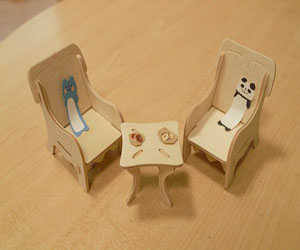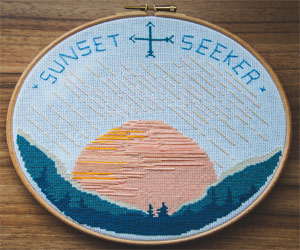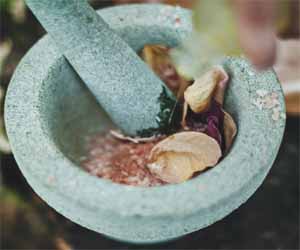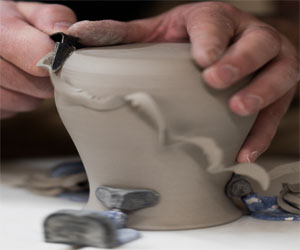


Crafting Creativity And Fulfillment

Woodworking, the art of shaping and crafting wood into functional or decorative objects, is not just a profession; it's a beloved hobby for countless individuals. Whether you're a novice or an experienced woodworker, the world of woodworking as a hobby offers a unique avenue for self-expression, creativity, and personal fulfillment. In this article, we'll delve into the reasons why woodworking is such a popular and rewarding pastime.
A Creative Outlet: Woodworking allows individuals to tap into their creative reservoirs. Whether you're designing a custom coffee table, carving intricate patterns on a wooden panel, or constructing a birdhouse, the scope for creative expression is vast. The ability to take raw materials and transform them into unique, personalized creations is immensely satisfying.
Stress Relief: Woodworking is a form of therapy for many enthusiasts. The process of working with wood engages the mind and body, providing an escape from the stresses of daily life. The rhythmic sounds of saws, the tactile feedback from sanding, and the meditative aspects of woodworking all contribute to a sense of relaxation and stress relief.
Sense Of Accomplishment: There's a profound sense of accomplishment that comes with completing a woodworking project. The act of seeing your vision take shape, from the initial design to the final finished piece, is incredibly rewarding. It builds confidence and self-esteem, and each project serves as a tangible testament to your skills and dedication.
Learning And Growth: Woodworking as a hobby is a journey of continuous learning and growth. It's an opportunity to acquire new skills and techniques, from mastering joinery methods to understanding different types of wood. The learning curve is steep, but the journey is part of the joy, as you gradually progress from simple projects to more complex creations.
Customization And Personalization: One of the most appealing aspects of woodworking as a hobby is the ability to customize and personalize your creations. You can design and build items that fit your specific needs and preferences. Whether it's crafting a piece of furniture that matches your home decor or constructing a gift that resonates with a loved one, woodworking empowers you to create truly unique and meaningful pieces.
Community And Camaraderie: Woodworking enthusiasts often find a supportive and like-minded community. Whether you're sharing your latest project with fellow hobbyists at a woodworking club, participating in online forums, or attending workshops, the sense of camaraderie and shared passion is a cherished aspect of the hobby.
Preserving Tradition And Heritage: Woodworking as a hobby allows individuals to carry forward traditions and heritage. Many woodworking techniques have been passed down through generations, and by engaging in this craft, you become a part of this rich legacy, preserving and passing on valuable knowledge.
Woodworking as a hobby is a gateway to a world of creativity, personal fulfillment, and lifelong learning. It's a hobby that encourages individuals to explore their artistic talents, find solace in the workshop, and experience the deep satisfaction of turning a simple piece of wood into a work of art. Whether you're crafting for practicality, artistic expression, or the pure joy of creating, woodworking offers a world of possibilities and a hobby that can be enjoyed for a lifetime.
Techniques For Discerning Palates
 Clarity: Assess the clarity of the wine. A hazy appearance might indicate issues with the wine's production, while crystal clarity suggests quality and careful handling.
Clarity: Assess the clarity of the wine. A hazy appearance might indicate issues with the wine's production, while crystal clarity suggests quality and careful handling.
Viscosity: Swirl the wine gently in the glass and observe the "legs" or "tears" that form on the side of the glass. Thicker legs indicate a higher alcohol content or residual sugar, which can provide clues about the wine's body.
2. Aroma Exploration: The aroma, or bouquet, of a wine is a critical aspect of the tasting experience. Swirl the wine in your glass to release its aromas, then take a moment to inhale. Wine's bouquet can be quite complex, and it's where the magic begins.
Primary Aromas: Primary aromas are derived from the grape variety itself. For instance, Chardonnay often exhibits scents of green apple or citrus, while Cabernet Sauvignon might have blackberry or black currant notes.
Secondary Aromas: These come from the fermentation process and often include scents like bread, yeast, or vanilla, particularly in the case of oak-aged wines.
Tertiary Aromas: Tertiary aromas develop during aging and might include earthy, spicy, or nutty notes.
3. Sip And Savor: Take a small sip of the wine and let it coat your palate. Assess the wine's taste, noting its flavors, acidity, sweetness, and tannins. Consider the balance and harmony of these elements.
Flavors: Describe the flavors you perceive, which can range from fruity and floral to earthy and spicy.
Acidity: Assess the wine's acidity, which can make it feel crisp and lively on your palate.
Sweetness: Determine the wine's level of sweetness, which can range from bone-dry to dessert-sweet.
Beauty From The Earth, For The Earth
 Nature's Bounty: Natural cosmetics are crafted from botanical and organic ingredients such as plant extracts, essential oils, and minerals. These clean ingredients nourish the skin, providing a safer and more holistic approach to beauty.
Nature's Bounty: Natural cosmetics are crafted from botanical and organic ingredients such as plant extracts, essential oils, and minerals. These clean ingredients nourish the skin, providing a safer and more holistic approach to beauty.
Clean Formulations: Natural cosmetics are free from harsh chemicals, synthetic fragrances, and toxic additives commonly found in conventional cosmetics. They prioritize the use of clean, safe, and non-toxic ingredients, reducing the risk of skin irritations, allergies, and long-term health concerns.
Environmental Consciousness: Many natural cosmetics brands embrace sustainable and eco-friendly practices. They focus on sourcing ingredients responsibly and use recyclable or biodegradable packaging, significantly reducing their environmental impact.
No Animal Testing: A significant portion of natural cosmetics is cruelty-free, meaning they don't test their products on animals. This aligns with the principles of ethical consumerism and compassionate treatment of animals.
Transparency And Accountability: Natural cosmetics brands are known for their transparency. They provide detailed information about their ingredients, sourcing, and production processes. This allows consumers to make informed choices about the products they apply to their skin.
Safer Makeup Alternatives: Natural cosmetics extend beyond skincare to include makeup products like foundation, lipstick, and mascara. Clean cosmetics offer safer alternatives for enhancing beauty without compromising health or the environment.
Holistic Beauty: Natural cosmetics encourage a holistic approach to beauty. They emphasize that beauty is not merely skin-deep and is deeply intertwined with overall well-being, mental health, and self-confidence.
Crafted With Love And Sustainability
 Uniqueness And Personalization
Uniqueness And Personalization
DIY upcycled gifts are unique and personalized. Each creation is one-of-a-kind, reflecting the maker's individual style and the recipient's preferences. Whether it's upcycled jewelry, a hand-sewn bag, or repurposed decor, the inherent charm of these gifts is in their distinctiveness.
Endless Possibilities
The possibilities for DIY upcycled gifts are virtually limitless. Some popular ideas include turning vintage teacups into candles, transforming old windows into picture frames, crafting planters from used containers, and creating tote bags from discarded clothing. With a little imagination and resourcefulness, the sky's the limit.
Getting Started With DIY Upcycled Gifts
Gather Materials: Start by collecting the materials you'll need for your chosen project. This may involve hunting for discarded items, vintage finds, or materials you already have at home.
Choose The Right Project: Select a DIY project that aligns with the recipient's tastes and needs. Consider their hobbies, interests, and the occasion.
Learn Techniques: If you're new to upcycling, research and familiarize yourself with the necessary techniques for your chosen project. There are numerous online tutorials, books, and resources available.
Personalize Your Creation: Add a personal touch to your upcycled gift. You can do this by incorporating the recipient's favorite colors, adding custom designs, or incorporating a heartfelt message.
Safety First: Be mindful of safety precautions, especially when working with tools, paints, or materials that may have sharp edges or require special handling.






Exploring The World Of Embroidery Stitches
 French Knot: A highly decorative stitch that creates raised, textured dots. These knots can be used for flowers, eyes, or other small, ornamental details.
French Knot: A highly decorative stitch that creates raised, textured dots. These knots can be used for flowers, eyes, or other small, ornamental details.
Chain Stitch: A looping stitch that forms a chain-like line. It's versatile and can be used for both lines and filling areas, creating a textured, rope-like appearance.
Feather Stitch: This stitch resembles the delicate fronds of a feather, with stitches on either side of a central line. It is often used to depict leaves, vines, or other organic elements.
Bullion Knot: A stitch that creates a raised, coiled effect. It's perfect for floral and three-dimensional embroidery work, adding depth and dimension.
Embroidery In Culture And Tradition: Regional Stitches
Different cultures around the world have their unique embroidery stitches and styles, often reflecting the traditions, values, and artistic sensibilities of their communities.
Sashiko (Japan): Known for its geometric, repetitive patterns, sashiko uses running stitches to create designs that are both decorative and functional. It's often used for mending and reinforcing fabric.
A Symphony Of Flavors And Aromas
 The beauty of herb gardens lies not only in the aromatic and flavorful treasures they offer but also in the diverse range of herbs that can be cultivated. These multifaceted gardens are a testament to the incredible variety of plants that can be grown for culinary, medicinal, and aesthetic purposes. In this article, we'll explore the world of herb garden diversity, celebrating the rich tapestry of flavors, aromas, and colors it can bring to your life.
The beauty of herb gardens lies not only in the aromatic and flavorful treasures they offer but also in the diverse range of herbs that can be cultivated. These multifaceted gardens are a testament to the incredible variety of plants that can be grown for culinary, medicinal, and aesthetic purposes. In this article, we'll explore the world of herb garden diversity, celebrating the rich tapestry of flavors, aromas, and colors it can bring to your life.
The Many Faces Of Herb Diversity
Herb gardens are a treasure trove of plant diversity. They encompass a vast array of herbs, each with its unique characteristics and uses:
Culinary Herbs: These are the culinary classics like basil, oregano, rosemary, and thyme, which infuse dishes with diverse flavors, from sweet and fragrant to earthy and robust.
Medicinal Herbs: Herbs like chamomile, lavender, and echinacea have been used for centuries for their healing properties. They offer a diverse range of remedies, from soothing teas to natural salves.
Aromatic Herbs: Lavender, mint, and lemon balm are renowned for their captivating aromas. They are often used for creating aromatic oils, perfumes, and potpourri.
Creating Art From Earth
 2. Stress Relief: Working with clay has a therapeutic effect. The tactile experience of manipulating the cool, moist material, combined with the meditative process of shaping, pinching, and molding, can help alleviate stress and promote mindfulness. As you immerse yourself in the creative process, daily concerns tend to fade away.
2. Stress Relief: Working with clay has a therapeutic effect. The tactile experience of manipulating the cool, moist material, combined with the meditative process of shaping, pinching, and molding, can help alleviate stress and promote mindfulness. As you immerse yourself in the creative process, daily concerns tend to fade away.
3. Sense Of Accomplishment: Completing a pottery project can be immensely rewarding. The tangible nature of the craft allows hobbyists to see the fruits of their labor take shape before their eyes. Whether it's the first pinch pot or a finely glazed vase, the sense of accomplishment is empowering and boosts self-esteem.
4. Functional And Decorative Items: Pottery offers a practical aspect as well. Hobbyists can create personalized, one-of-a-kind items for everyday use, such as plates, bowls, and utensils. These functional pieces can add a special touch to your home while showcasing your craftsmanship. Alternatively, pottery can be used to craft decorative items, making your living space uniquely beautiful.
5. Continuous Learning: Pottery is a hobby that offers endless opportunities for learning and growth. From mastering basic techniques like coiling, slab-building, and wheel-throwing to experimenting with glazes, there's always something new to discover.